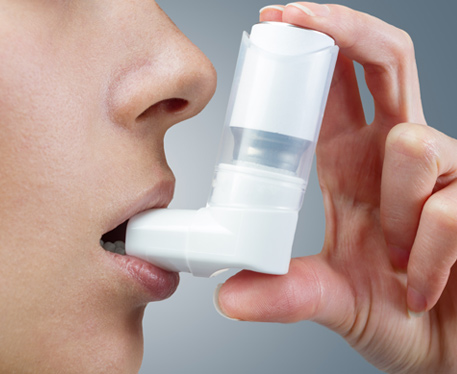
Asthma is characterized by recurrent episodes of wheezing, shortness of breath, chest tightness, and coughing. Sputum may be produced from the lung by coughing but is often hard to bring up. During recovery from an attack it may appear pus like due to high levels of white blood cells called eosinophils. Symptoms are usually worse at night and in the early morning or in response to exercise or cold air. Some people with asthma rarely experience symptoms, usually in response to triggers, whereas others may have marked and persistent symptoms.
Many environmental factors have been associated with asthma's development and exacerbation including allergens, air pollution, and other environmental chemicals. Smoking during pregnancy and after delivery is associated with a greater risk of asthma-like symptoms. Low air quality from factors such as traffic pollution or high ozone levels has been associated with both asthma development and increased asthma severity. Exposure to indoor volatile organic compounds may be a trigger for asthma; formaldehyde exposure, for example, has a positive association. Also, phthalates in PVC are associated with asthma in children and adults.
Asthma is associated with exposure to indoor allergens. Common indoor allergens include: dust mites, cockroaches, animal dander, and mould. Efforts to decrease dust mites have been found to be ineffective. Certain viral respiratory infections, such as respiratory syncytial virus and rhinovirusmay increase the risk of developing asthma when acquired as young children. Certain other infections, however, may decrease the risk.
Family history is a risk factor for asthma, with many different genes being implicated. If one identical twin is affected, the probability of the other having the disease is approximately 25%. By the end of 2005, 25 genes had been associated with asthma. Many of these genes are related to the immune system or modulating inflammation. Even among this list of genes supported by highly replicated studies, results have not been consistent among all populations tested.
Home factors that can lead to exacerbation of asthma include dust, animal dander (especially cat and dog hair), cockroach allergens and mold. Perfumes are a common cause of acute attacks in women and children. Both viral and bacterial infections of the upper respiratory tract can worsen the disease. Psychological stress may worsen symptoms—it is thought that stress alters the immune system and thus increases the airway inflammatory response to allergens and irritants.
Spirometry is recommended to aid in diagnosis and management. It is the single best test for asthma. If the FEV1 measured by this technique improves more than 12% following administration of a bronchodilator such as salbutamol, this is supportive of the diagnosis. It however may be normal in those with a history of mild asthma, not currently acting up. As caffeine is a bronchodilator in people with asthma, the use of caffeine before a lung function test may interfere with the results. Single-breath diffusing capacity can help differentiate asthma from COPD. It is reasonable to perform spirometry every one or two years to follow how well a person's asthma is controlled.
Medications used to treat asthma are divided into two general classes: quick-relief medications used to treat acute symptoms; and long-term control medications used to prevent further exacerbation.
• Fast–acting Salbutamol metered dose inhaler commonly used to treat asthma attacks.
• Short-acting beta2-adrenoceptor agonists such as salbutamol (albuterol USAN) are the first line treatment for asthma symptoms. They are recommended before exercise in those with exercise induced symptoms.
• Anticholinergic medications, such as ipratropium bromide, provide additional benefit when used in combination with SABA in those with moderate or severe symptoms. Anticholinergic bronchodilators can also be used if a person cannot tolerate a SABA.
Long–term control
• Fluticasone propionate metered dose inhaler commonly used for long-term control.
• Inhaled forms such as beclomethasone are usually used except in the case of severe persistent disease, in which oral corticosteroids may be needed. It is usually recommended that inhaled formulations be used once or twice daily, depending on the severity of symptoms.
• Long-acting beta-adrenoceptor agonists (LABA) such as salmeterol and formoterol can improve asthma control, at least in adults, when given in combination with inhaled corticosteroids. In children this benefit is uncertain. When used without steroids they increase the risk of severe side-effectsand even with corticosteroids they may slightly increase the risk.
• Leukotriene antagonists (such as montelukast and zafirlukast) may be used in addition to inhaled corticosteroids, typically also in conjunction with LABA.Evidence is insufficient to support use in acute exacerbations. In children they appear to be of little benefit when added to inhaled steroids. In those under five years of age, they were the preferred add-on therapy after inhaled corticosteroids by the British Thoracic Society in 2009.
Delivery methods
Medications are typically provided as metered-dose inhalers (MDIs) in combination with an asthma spacer or as a dry powder inhaler. The spacer is a plastic cylinder that mixes the medication with air, making it easier to receive a full dose of the drug. A nebulizer may also be used. Nebulizers and spacers are equally effective in those with mild to moderate symptoms. However insufficient evidence is available to determine whether a difference exists in those with severe disease.